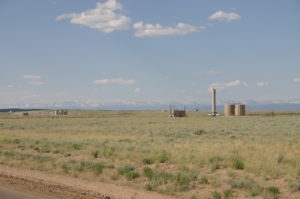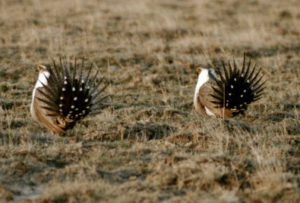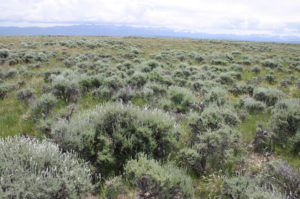
This story was written by the research team and communication officers from the U.S. Geological Survey.
Greater sage-grouse populations in Wyoming declined 2.5 percent annually between 1984 and 2008, with oil and gas development being associated with the decline. A new study from the U.S. Geological Survey and Colorado State University used the annual counts of male sage-grouse at communal breeding sites, known as leks, as a measure of population size over time.
Sage-grouse population data in Wyoming were analyzed in relation to the density of oil and gas wells and the area of disturbance associated with these wells. The analysis also included information about the distance of wells from leks, the potential for a delayed response of sage-grouse populations following well development, characteristics of sagebrush habitat and amount of precipitation.
“Energy development continues to affect important sagebrush habitat required by sage-grouse and other species,” said Cameron Aldridge, an associate professor in the Department of Ecosystem Science and Sustainability at Colorado State University who cooperated with the USGS on the research. “This analysis provides new information to managers on how sage-grouse populations respond to energy development, as they simultaneously work to implement conservation measures for sage-grouse and meet demands for additional energy supplies.”
Populations were stable when no wells were present near a lek and then began declining with the addition of the first well. Declines were not statistically significant until well density reached about 10.4 wells per square mile. At this well density, however, populations were predicted to decline 14 percent per year.

“This approach allowed us to look at long time periods, including years before the oil and gas boom, which gave us a better picture of how sage-grouse have responded to oil and gas development,” said Adam Green, lead author of the paper and a former research scientist at Colorado State University. “We found evidence of decreasing populations in response to increasing oil and gas development. This response was apparent as far as four miles from a lek, and the response was strongest four years following development.”
Global energy demand is expected to increase substantially in the next two decades, with fossil fuels accounting for more than one-third of that demand. Many studies have shown negative effects of energy development on wildlife, including declining populations, loss of biodiversity and modified behavior. Concerns over declining greater sage-grouse populations have led to the establishment of Sage-grouse Priority Habitat Management Areas for conservation as protective measures to maintain suitable habitat and manage negative effects associated with oil and gas development and other disturbances.
“The four-year delay in the response after well development may be an indication that energy development is impacting the production of male sage-grouse in the breeding population.” said Steve Hanser, USGS sagebrush ecosystem specialist. “Male sage-grouse reach maturity after two to three years, so if development hinders recruitment there can be a delayed population response as adult males die and are not replaced by young males.”

The results of this analysis suggest that allowable well densities that average one well pad per 640 acres (with up to 64 wells per pad) within Sage-grouse Priority Habitat Management Areas, called Core Areas in Wyoming, may only be sufficient for limiting population declines to current rates, but not for reversing the trend.
While this study evaluated population trends from 1984 to 2008, this was prior to management changes associated with the Wyoming Core Area Policy. Thus, this paper does not assess the effectiveness of that policy.
Greater sage-grouse occur in parts of 11 U.S. states and two Canadian provinces in western North America. Implementation of effective management actions for the benefit of sage-grouse continues to be a focus of Department of the Interior agencies following the 2015 decision by the U.S. Fish and Wildlife Service that the species is not warranted for listing under the Endangered Species Act.
The research is published in the Journal of Wildlife Management.